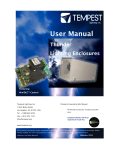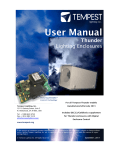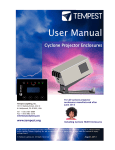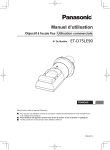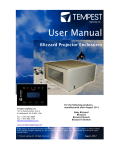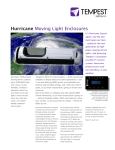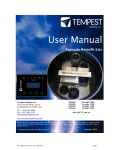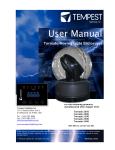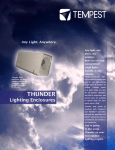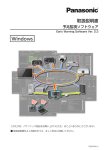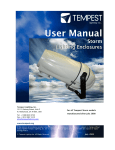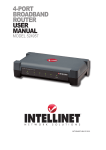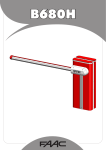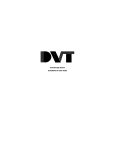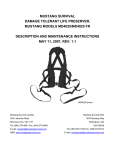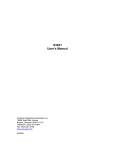Download Typhoon User Manual
Transcript
User Manual and Installation Guide User Manual Tornado Moving Light Enclosures Heater Fan On Relay Temp DMX Lamp ESC OK Tempest Lighting, Inc. 11845 Wicks Street Sun Valley, CA 91352, USA For all Typhoon projector enclosures manufactured after June 2015 Tel +1 818 787 8984 Fax +1 818 252 7101 [email protected] www.tempest.org In the interest of continuous product improvement, the information in this document is subject to change without notice. Neither Tempest Lighting, Inc. nor its representatives or agents may be held liable for expense or injury arising from it. © Tempest Lighting Inc. All Rights Reserved Typhoon Enclosure User Manual July, 2015 page 1 Table of Contents 1 Introduction ..................................................................................................................... 4 Dimensions – Typhoon 8800.................................................................................... 5 Dimensions – Typhoon 8810, 8820 ......................................................................... 6 Typhoon Rigging Accessories .................................................................................. 7 Landscape Angles and Portrait Orientation.............................................................. 8 Thermal Insulation Kit .............................................................................................. 9 Power and Signal Connector Options ....................................................................... 9 2 Installation ..................................................................................................................... 10 Safety and Warnings ............................................................................................... 10 Planning .................................................................................................................. 11 Mounting................................................................................................................. 12 3 Wiring ............................................................................................................................. 13 One or Two Power Circuits? .................................................................................... 15 Single Feed Operation (factory default) .................................................................. 16 Split Feed Operation ............................................................................................... 16 Power Connections ................................................................................................. 17 4 Digital Enclosure Control – DEC3.3TM with GoldilocksTM ................................................. 19 DEC3.3 Schematic ................................................................................................... 20 DEC3.3 Main Functions........................................................................................... 21 Factory Settings – Basic Mode ................................................................................ 21 Operating Modes .................................................................................................... 22 DEC3.3 Control Parameters .................................................................................... 23 Start-up Validation .................................................................................................. 24 DMX Connections ................................................................................................... 25 Remote Device Management (RDM)........................................................................ 26 Control Interface ..................................................................................................... 27 RDM Monitoring and Configuration ....................................................................... 31 Firmware Upgrade over RDM .................................................................................. 32 Tempest Temp Communications Firmware ............................................................ 33 5 Mounting the Projector .................................................................................................. 36 6 Closing up the Enclosure ............................................................................................... 41 7 Operation ....................................................................................................................... 42 8 Routine Maintenance ..................................................................................................... 43 9 Troubleshooting ............................................................................................................ 45 10 Limited Warranty ............................................................................................................ 46 11 Tempest Product Support .............................................................................................. 47 Air Filter Maintenance & Replacement.................................................................... 44 Typhoon Enclosure User Manual page 2 CERTIFICATE AND DECLARATION OF CONFORMITY FOR CE MARKING Tempest Lighting, Inc. 13110 Saticoy Street, Unit C, North Hollywood, CA 91605, USA t: +1 818 787 8984 f: +1 818 982 5770 e: [email protected] www.tempest.org Tempest Lighting, Inc. declares that their Typhoon Projector Enclosure Series 88xx.xxx complies with the Essential Requirements of the following EU Directives: Low Voltage Directive 2006/95/EC Electromagnetic Compatibility Directive 2004/108/EC Test Report 60065-6500-01 Test Report 61000-6500-03 and further conforms with the following EU Harmonized Standards: EN 60065 : 2002 EN 60529:2001-2002 EN 61000-6-3:2007+A1:2011 EN61000-6-1:2007 EN55015:2006+A2:2009 Test Test Test Test Test Report Report Report Report Report 60065-6500-01 60529-6500-02 61000-6500-03 61000-6500-03 61000-6500-03 Dated: 1st March, 2015 Position of signatory: President Name of Signatory: Tim Burnham Signed below: on behalf of Tempest Lighting, Inc. ............................. Typhoon Enclosure User Manual page 3 1 Introduction Products Covered by this Manual Typhoon 8800.xx Typhoon 8810.xx Typhoon 8820.xx Note: For Christie Boxer 30K For Panasonic PT-DZ21K For DPI Titan Quad xx = Part # suffix .US for North American 208V electrical systems xx = Part # suffix .IN for European 230V electrical systems Using This Manual Please read this manual in its entirety before starting work. All the information contained is important, and should be read carefully before proceeding. Heed all warnings and advisories. Icon Key: Valuable information Electrical Warning Safety Information Typhoon Enclosure User Manual page 4 Dimensions – Typhoon 8800 Typhoon Enclosure User Manual page 5 Dimensions – Typhoon 8810, 8820 Typhoon Enclosure User Manual page 6 Typhoon Rigging Accessories Typhoon enclosures may be specified with a wide variety of rigging and installation accessories to suit any permanent installation or event rig. All rigging accessories use the same pattern of M12 mounting holes on the top and bottom of the enclosure. 8800.TC Set of 4 Truss Clamps and Unistrut Hardware (requires 8800.UR) 8800.UR Pair Stainless Steel Unistrut Rails – May be mounted top or bottom to attach to a structure or to support truss clamps 8800.SK Stacking Kit 8800.DA Pair of adjustable drop arms (requires 8800.SK) 8800.GH Pair of steel Grab handles for lifting and carrying Typhoon Enclosure User Manual page 7 Landscape Angles and Portrait Orientation Typhoon enclosures may be installed in either landscape or portrait orientation, and at any angle supported by the projector in use. If the enclosure is angled more than about 30 degrees in any direction, including portrait orientation, add a Typhoon Inlet Cowl (8800.IC) to protect the inlet filter from weather or from blown sand in desert installations. The Inlet Cowl may be installed with its opening in any direction – always install with the opening at the lowest point. 8800.IC Typhoon Inlet Cowl. Install with the 6 M4 screws supplied, opening facing down. Exhaust Louvers in Portrait Operation Typhoon 8800: Remove exhaust louver, turn 90 degrees and replace. Typhoon 8810, 8820: Remove exhaust louver and replace with a portrait exhaust louver, item # 8810.PEL. Typhoon Enclosure User Manual page 8 Thermal Insulation Kit Specify a factory-fitted Thermal Insulation Kit if the Typhoon enclosure is to be used in either hot (over 30C) or cold (below 0C) environments. The thermal insulation kit provides 1” [25mm] of thermal insulating foam lining to moderate internal temperatures, conserve heat in cold climates, and reduce heat-induced stress and fan use in hot environments. Power and Signal Connector Options All Typhoon orders are configured to the user’s specification for power and signal connector options. For the purposes of this manual it is assumed that the default conduit connections will be used. Typhoon Enclosure User Manual page 9 2 Installation Safety and Warnings These warnings are for your protection. Failure to comply may result in serious injury or death. Tempest Lighting, Inc. assumes no responsibility for damages or injury incurred by misuse or mishandling of product. Do not attempt to install or operate the enclosure before fully reading and understanding this manual Never allow anyone who has not read this manual to open the enclosure or perform maintenance on the projector within. Never leave the enclosure unattended when open. Always make sure all bolts and latches are tight and safety locks are in place after performing any form of maintenance on the unit. Do not open any electrical boxes until power has been shut off to all supply lines to the enclosure (including the one powering the projector). Do not open the enclosure in wet weather. Typhoon Enclosure User Manual page 10 Planning Snow clearance: MINIMUM 24”/60cm Observe the following MINIMUM clearances around enclosure for access and ventilation. Air Inlet Clearance Access Clearance 3” [75] EITHER: 40” [1000] 18” [450] 30” [750] OR: 40” [1000] Typhoon Enclosure User Manual page 11 Mounting The Typhoon enclosure is provided with 12 M12-1.75 threaded sockets for direct mounting or attaching rigging accessories, six on top and six on the bottom surface. See dimensions p5-6. You may attach Typhoon to a suitable structure directly by using these mounting holes and stainless steel M12-1.75 bolts. Be sure to use the rubber washers supplied to ensure weather seal. OR, you may use any of the rigging accessories shown on p7. IN ALL CASES: Each Enclosure must be mounted at FOUR points, one at each corner. All mountings must be made using the mounting hardware provided. Tempest Lighting recommends the use of stainless steel mounting hardware. IMPORTANT SAFETY NOTICE: Installer must ensure that all mounting points are secure and conform to local safety regulations. Tempest Lighting Inc. accepts no responsibility for damage or injury arising from inappropriate or unsafe installation. Typhoon Enclosure User Manual page 12 3 Wiring All electrical work must be carried out by a properly licensed electrician, in compliance with local electrical standards. Failure to observe this point will void the factory warranty for the Tempest Enclosure. 1 Switch off power to the branch circuit, carefully following lockout and tag-out procedures. Failure to do so could cause serious injury or death. 2 CONDUIT CONNECTIONS: You will need two electrical junction boxes, located within a short distance from the enclosure, one for power, one for signal (usually CAT5). Use outdoor-rated flexible conduit between the box and the enclosure, to allow for the back door to open. 3 AC and signal circuits must be wired in separate conduits. AC Power Requirement – North America The Typhoon enclosure runs on 208VAC, 50/60Hz. And requires up to 5Amps. In addition, the internal 120V power supply for auxiliary AV equipment inside the enclosure requires a neutral. Power may be supplied separately to the enclosure and the projector (see wiring section below). For Single feed systems, supply: 208V (2 hots), rated for the projector plus 5Amps Neutral Ground For Split Feed Systems, supply: Enclosure: 208V (2hots), Neutral, Ground Projector: 208V (2 hots), Ground AC Power Requirement – International The Typhoon enclosure runs on 200-250VAC, 50/60Hz. And requires up to 5Amps, plus power required for auxiliary AV equipment connected to the internal 230V IEC C14 outlets. Power may be supplied separately to the enclosure and the projector (see wiring section below). For Single feed systems, supply: 230V rated for the projector plus 10Amps (5Amps enclosure plus 5Amps auxiliary), LNE For Split Feed Systems, supply: Enclosure: 230V 10Amps (5Amps enclosure plus 5Amps auxiliary), LNE Projector: 230V rated for projector power, LNE Typhoon Enclosure User Manual page 13 Conduit Entry 208VAC or 230VAC Holes 1.05”/17mm for US Picture Source ¾” NPT Conduit Fittings, 25mm International. AC Power Signal Conduit Entries may be fitted with flexible conduit fittings or cable glands (not included) Flexible Conduit 4 CONNECTORIZED ENCLOSURES Use appropriate flexible cables and connectors to connect to the connectors specified on the rear panel. These will vary with each enclosure and customer – a typical example is shown here, with 30Amp power inlet, OpticalCon and BNC passthroughs. Typhoon Enclosure User Manual page 14 One or Two Power Circuits? 1 Single Feed 1 2 Split Feed Tempest enclosures may be wired on single or double line supplies. On a single feed, both enclosure and projector are permanently on. With a split feed supply, you can switch off the projector when not in use, while the enclosure continues to protect it 24/7. Single Feed Split feed Enclosure and projector are Enclosure power must be permanently ON. permanently on. Enclosure and Projector must be rated for the same voltage. Supply must be rated for projector current plus 150 watts. Supply must be permanently ON. Typhoon Enclosure User Manual Projector power may be switched off. Enclosure power must be rated for 1150W Projector power must be rated for the projector (see projector manual). Projector and enclosure power must be same voltage. page 15 Single Feed Operation (factory default) 1 Enclosure and projector share the same electrical circuit. Circuit must be powered ON 24/7. Connect incoming power to the terminals labeled MAINS: (E) Earth/Ground (L) Live (N) Neutral Fan 1 Fan 2 E L N Heater(s) Feed Operation Projector Supply SplitEnclosure Supply (split mode) Enclosure (100-250VAC 50/60Hz) and projector have separate electrical feeds. The enclosure circuit must be powered ON 24/7. When splitting the feeders, both circuits should be on the same phase and at the same supply voltage. it n or e 1 Use a wire cutter to cut the copper links on the DEC3.2 board in four places. 2 Connect incoming ENCLOSURE power to the terminals labeled MAINS. This supply MUST be maintained 24/7. (E) Earth/Ground (L) Live (N) Neutral Fan 1 3 E L N Projector Power Projector Supply (split mode) E L N Enclosure Power Connect incoming PROJECTOR power to the terminals labeled SPLIT: (E) Earth/Ground Fan 2 Heater(s) (L) Live (N) Neutral Enclosure Supply (100-250VAC 50/60Hz) Typhoon Enclosure User Manual page 16 Power Connections IMPORTANT Tempest enclosures are supplied for either 120VAC 50/60Hz, or 208-240VAC, 50/60Hz operation. Tempest Lighting is not liable for damage or failure to operate correctly due to connection to an inappropriate electrical supply. ALL ELECTRICAL CONNECTIONS MUST BE UNDERTAKEN BY A QUALIFIED ELECTRICIAN, IN COMPLIANCE WITH LOCAL NORMS AND STANDARDS. Cut here for split supply operation Fan 1 Projector receptacle Fan 2 Heater(s) Projector Supply (split mode) Enclosure Supply (100-250VAC 50/60Hz) Note: wire colors may differ depending on applicable electrical standards. European wire colors are shown here. IMPORTANT: MAKE SURE THAT TERMINAL SCREWS ARE FULLY BACKED OUT BEFORE INSERTING WIRES. Typhoon Enclosure User Manual page 17 Auxiliary Power Outlet An auxiliary power outlet is provided for any auxiliary equipment needed (routers, CD players etc) in the enclosure. Wiring is different dependent on electrical standard: North America (208 volt Typhoon enclosures with .US part # suffix) Pigtail with Edison 15A 120V outlet International (230 volt Typhoon enclosures with .IN part # suffix) Pigtail with IEC C14 outlet, rated 10A @ 230V Note: Projector Connectors Typhoon 8800 enclosures are provided with IEC 309 32A (US Pin and Sleeve 30A) line female pigtails to plug to the Christie Boxer power inlet. Typhoon 8810 and 8820 enclosures are provided with IEC C19 female pigtails to connect to projector power inlets. Typhoon Enclosure User Manual page 18 4 Digital Enclosure Control – DEC3.3TM with GoldilocksTM Heater Fan On Relay Temp DMX Lamp ESC OK DEC3.3TM – that’s Digital Enclosure Control, third Generation, revision 3 – is the brain of your Tempest enclosure. It will maintain the internal environment in a comfortable temperature and humidity range, and prevent condensation – the real killer of outdoor equipment. DEC3.3 monitors internal temperature, humidity and lamp current at all times, and uses this information to control the enclosure’s lamp relay, fan(s) and heater(s). It can report back over the DMX cable, using the RDM protocol (Remote Device Management) if desired. From summer 2013 DEC is running Tempest’s new GoldilocksTM operating system (patents pending). A completely new OS, Goldilocks analyzes temperature and humidity trends, targeting and maintaining safe ranges, and acting to prevent condensation before it happens. Goldilocks is also much more energy-efficient than previous generations, so your equipment is always in the Goldilocks zone, and you save money too. Typhoon Enclosure User Manual page 19 DEC3.3 Schematic AC Supply (must be on at all times) Split Feed (optional) Cut the links for split feed operation X Sensor X AC Heater(s) AC Fan(s) OUT IN OUT IN DMX/RDM – RS485 (Optional) Which Controller? The following Table shows which controller is used in different types of Tempest Enclosure. This section does NOT apply to enclosures with Tempest MiniDEC TM Control Enclosure Type DEC3.3/Goldilocks Blizzard Indoor HUSH Outdoor HUSH Outdoor Thunder Outdoor Special order Tornado Outdoor Twister Outdoor Typhoon Typhoon Enclosure User Manual MiniDEC page 20 DEC3.3 Main Functions 1 Sense current to projector (lamp on/off) 2 Record lamp hours 3 Monitor temperature and humidity inside Enclosure 4 Maintain temperature at safe operating level 5 Maintain relative humidity within safe limits 6 Prevent condensation 7 Isolate projector in case of unsafe temperature 8 Report status over RDM 9 (Optional) remote projector relay control over DMX DEC3.3 constantly monitors the following parameters: Projector/Luminaire power Line Voltage Temperature Humidity DEC 3.3’s patented GoldilocksTM algorithm uses a combination of heaters and fans to maintain a safe operating temperature and a safe relative humidity level that will not allow condensation to take place. As air is heated it is able to support more moisture without condensing, so Goldilocks uses heat to raise the air temperature inside the enclosure in the event that relative humidity approaches dewpoint. Factory Settings – Basic Mode In most applications, DEC3.3 will operate correctly with its factory default settings, in Basic operating mode. You do not need to do anything. Please skip to the Power Connections section below. If your needs are more complex, read on. Typhoon Enclosure User Manual page 21 Operating Modes DEC3.3 may operate in one of four modes, set using either the Front Panel or by RDM control. In all configurations, the projector inside the enclosure may also be an RDM enabled device. Basic Mode (factory setting) Standard temperature settings DMX and RDM disabled Best for standalone operation Monitor Mode As Basic mode, plus: RDM status reporting RDM configuration – settings may be changed remotely or at the enclosure control panel DEC3.3 does not require a DMX signal to operate Control Mode As Basic mode, plus: Enclosure functions as a 1-channel DMX device, with remote control of the lamp relay o DMX level > 75% enables normal relay operation (normally ON) o DMX level < 25% disables normal relay operation (relay turns OFF) o This allows you to force a hard reset of the lamp relay in the event of a projector malfunction Control mode is recommended for show control applications, but can be risky in live show operation, since the DMX slot used for the enclosure MUST be kept high to prevent the lamp relay from opening. Service Mode For trained service personnel only Normal operation is suspended and the enclosure functions as a 3-channel DMX device: o Lamp Relay (Slot 1) o Fans (Slot 2) o Heater (Slot 3) Service mode is ONLY for troubleshooting – DO NOT use Service mode for normal operation. Typhoon Enclosure User Manual page 22 DEC3.3 Control Parameters Temperature and Humidity Ranges: Cooling Fan(s) Trip Temp (55-70˚C, Default 60 ˚C) Low Upper Temp (35-50˚C, Default 40 ˚C) Relative Humidity (50-90%, Default 80%) Trend Temp (Dynamic) IdealTemp (Dynamic, based on Relative Humidity) High Heater(s) LowerTemp (0-10˚C, Default 0 ˚C) Notes: 1 In moving light enclosures the temperature sensor is located in the exhaust airflow. Temperatures shown may be higher than those around the projector. 2 We recommend using the factory default settings for several weeks or months before making any changes. In most cases they will not be necessary. Max Humidity Range 50-90%, Default 80% The threshold at which air inside the enclosure is heated to raise dewpoint and prevent condensation. Setting a higher Max Humidity is not a bad thing in highhumidity climates. Setting the Max Humidity too low will result in unnecessary heating and excessive energy use. So set the Max Humidity at the top end of the relative humidity likely to be experienced on site. DMX Address Range 001-510, Default 001 Sets the DMX address for the lamp relay control. (See also DMX Response) Set Temp Units Display Degrees Celsius or Fahrenheit. Default Celsius Note that temperature settings must always be Celsius. Lamp Hours Default 0000 Counts lamp hours – you must reset to zero when changing lamps. Lamp On Point The lamp current at which DEC detects the projector/luminaire lamp is running. Default is 1 Amp, which allows for equipment fans and power supplies to run without changing the air in the enclosure. Lamp on point may be set in 0.2 Amp increments between 0.2 Amps and 2.0 Amps. Typhoon Enclosure User Manual page 23 Start-up Validation When you switch power ON to the DEC3.3 controller (firmware 01.00.006 and up), the following indications will confirm that the major system elements are working correctly: BEEP! – a loud beep indicates that the processor has initialized and is functioning correctly. FANS – fans run for three seconds HEATER – the heater turns on for 15 seconds. This is enough to get warm to the touch. Typhoon Enclosure User Manual page 24 DMX Connections DMX refers to USITT DMX512, a commonly used control protocol in the entertainment industry, running over RS485. Consult USITT DMX installation guidelines when laying out a system, or employ a qualified DMX system integrator. A DMX network will be required if: a) The projector inside the enclosure requires a DMX control signal b) You wish to monitor the enclosure using RDM c) You wish to control the enclosure lamp relay over DMX DMX Terminations Note: DMX will not normally be used in projector installations. Pinout: (1) Ground, (2) Data -, (3) Data +. DMX Connectors: ❹ ❸ ❷ ❶ 1 DMX IN from network 2 DMX OUT to projector (or to network if not controlling projector) DMX OUT to next DMX device DMX IN from outside world 3 DMX IN from projector 4 DMX OUT to network Note: If the enclosed equipment does not use DMX, then connector (2) on the controller is DMX OUT for the enclosure. DMX Line Terminations DMX cable runs must be terminated at the far end of the cable run with a termination resistor as detailed in the DMX512 standard. The individual equipment installed inside the Tempest enclosures must NOT be terminated. + ‒ G DMX OUT + ‒ G DMX IN LIGHT + ‒ G DMX OUT LIGHT Typhoon Enclosure User Manual + ‒ G DMX IN It is recommended that any line termination is done using the 3-pin terminal connector fitted to the DEC3.3 control circuit board. page 25 Remote Device Management (RDM) RDM refers to ANSI E1.20, a control protocol in the entertainment industry used for device configuration and monitoring, and essentially an “extension” of DMX512. The use of RDM is optional, and uses the same RS485 cable connection as DMX512, so no additional wiring is required if DMX is already present. The user must ensure that any DMX splitters or other routing devices used are RDM operable as well as DMX use. Tempest strongly recommends working with a qualified RDM system integrator when designing an RDM network. Go to www.tempest.org for contact information. RDM and RDM Integration DEC3.3’s RDM implementation allows system integrators to remotely configure, control or monitor DEC3.3 attributes, including: Relative Humidity Heater Relay Status Air Temperature DMX Status PCB Temperature DMX Start Address Lamp Current DMX Personality (RDM Mode) Elapsed Lamp Hours Device Type Lamp Relay Status Device Label Fan Relay Status Software Version RDM is an effective and powerful tool for commissioning and monitoring an installation, particularly in large systems. For further guidance, please consult a qualified RDM system integrator. Tempest Lighting warrants DEC3.3 to be compliant with the RDM standard, but is not an RDM systems integrator, and can offer only basic guidance on RDM utilization. Typhoon Enclosure User Manual page 26 Control Interface LED Indicators Heater ON (Green) Heater is ON, to maintain lower temperature level or to prevent condensation Fan ON (Green) Lamp is ON, or Temperature is HIGH and Fan is cooling enclosure. Short burst when lamp off indicates fan moving air to stabilize temp/humidity Lamp On ON (Green) Current sensing shows lamp is ON Lamp hour counter is running OFF Current sensing shows lamp is OFF Lamp hour counter is not running Lamp Relay ON (Green) Lamp relay is closed (normal) Projector power receptacle is energized ON (Red) Lamp relay is open due to over-temperature event. Projector power receptacle is isolated. Temp FLASHING Temperature is below lower temp setting (Green) ON (Green) Temperature is in normal range ON (Amber) Humidity is above target limit ON (Red) Temperature is above top setting FLASHING (Red) Temperature is above Trip level Projector power is isolated DMX OFF DEC3.3 is in BASIC Mode – DMX not used. OR DEC3.3 is in Monitor or Control Mode and no valid DMX or RDM packet has been detected. ON (GREEN) Good DMX or RDM data packet received. ON (RED) Control Mode: DMX Fail. A previously good DMX signal has failed. Monitor Mode: No RDM information being received (this is normal) Typhoon Enclosure User Manual page 27 Control Display The display on the Control display provides additional status information, depending on the operating mode: Basic Mode & Monitor Mode 28˚C 209V 47% OFF internal temperature, relative humidity line voltage, lamp status DMX Mode & Service Mode 28˚C 209V 47% OFF internal temperature, relative humidity line voltage, lamp status Alternating with: DMX: 001 No DMX DMX Start Address DMX Status Control Interface Operation The Control Interface is normally LOCKED. To UNLOCK, hold ESC and OK together for 5 seconds. You are now in the CONTROL MENU Use to scroll up and down the menu. Press OK to enter a menu item Use to set the item parameter, or to scroll to the next menu level. Use ESC to go BACK, and OK to confirm settings ( ). To LOCK, hold ESC for 5 seconds. Menu will time out after ten minutes. Typhoon Enclosure User Manual page 28 Control Menu SET DMX OPTIONS SET DMX MODE From the Front Panel, this menu item allows the user to check (and if necessary change) the RDM mode. BASIC Standalone operation, no DMX/RDM (factory default) MONITOR Standalone, plus support for RDM remote configuration and monitoring CONTROL Monitor, plus use of a single DMX slot to control Lamp relay SERVICE Monitor, plus use of three DMX slots to control Lamp, Heater and Fan Important: Please ensure that the DEC3.3 is NOT left in Service Mode. SET DMX ADDRESS (in Monitor, Control or Service modes) Select a DMX starting address in the range 001 to 510 1 – Lamp Relay In Service Mode an addition two slots are available 2 – Fan Duty Control 3 – Heater Duty Control Note that the DMX control is designed using a SAFETY pile-on Logic. So the DMX input can only override automatic settings within safe limits. SET DMX CURVE DMX Curves affect the way the fixture relay is controlled in Control Mode. DMX levels are shown as %. Response Curve 1 (default) DMX level 0-25 Relay disabled (open) DMX level 26-75 No change to relay status DMX level 76-100 Relay enabled (normally closed) Response Curve 2 DMX level 0-19 No change to relay status DMX level 20-40 Relay disabled (open) DMX level 41-59 No change to relay status DMX level 60-80 Relay enabled (normally closed) DMX level 81-100 No change to relay status SET DMX RESPONSE DMX Response sets a delay time before DMX Control Mode settings are acted on. Setting a response delay of a few seconds would prevent unintended fixture relay state changes in the event of a short accidental change in DMX level. Typhoon Enclosure User Manual page 29 NOTE: from firmware revision 0.00.100, DEC holds last valid DMX level if DMX is interrupted. Response Delay Values are: No Delay (default), 1, 2, 5, 10, 15, 20, 30, 60 seconds. SET TEMP UNITS Choose to display temperature values in Celsius or Fahrenheit (default Celsius) Note that temperature settings must be entered in Celsius. SET TEMP RANGES Set three temperature trigger points for Bottom, Top and Trip temperatures, in °C. SET TEMP LOWER (minimum temperature to be maintained) (default 0°C, permissible range 0-10°C). SET TEMP UPPER (maximum desired temperature) (default 40°C, permissible range 35-50°C). SET TEMP TRIP (temperature at which load will be isolated – see note) (default 60°C, permissible range 55-70°C). Note: A thermal emergency is when enclosure ventilation fails with the lamp on, in which case the temperature will rise very quickly. To avoid nuisance tripping we recommend setting a higher Trip temperature, 60°C or above. SET MAX HUMIDITY (default 80%, permissible range 50-90%). Set target maximum relative humidity level. This should be set at or a few % higher than the normal high humidity levels expected on site. SET LAMP ON POINT The lamp current at which DEC detects the projector/luminaire lamp is running. Default is 1 Amp, which allows for equipment fans and power supplies to run without changing the air in the enclosure. Lamp on point may be set in 0.2 Amp increments between 0.2 Amps and 2.0 Amps. RESET LAMP HOURS Reset each time you change the lamp in the projector/projector. Make this a part of your maintenance instructions. STATUS DISPLAY View current status information, using the arrow keys to scroll through: a) Humidity – relative humidity in % b) Air temperature, in degrees C or F c) PCB temperature (this will usually be significantly higher than air temperature) d) Voltage – line Voltage reaching the DEC Typhoon Enclosure User Manual page 30 e) Current being drawn by projector/light, in Amps f) Lamp Hours elapsed since last reset g) Firmware version RDM Monitoring and Configuration All the features accessible over the DEC3.3 control panel are also available over RDM. Just how this information is displayed will depend on the RDM interface used. These screen shots were taken running the GetSet program in Windows 7, and connecting to a DEC3.3 controller using a RDM TRI MK1 interface, Tempest part # 2000.190 This view shows a single DEC3.2 test unit that has been correctly discovered and labeled by the GetSet software suite, and a log of RDM messages. This RDM interface provides a graphic view of the various sensor functions supported by DEC3.2 and up Important: Check that your RDM interface vendor has tested his interface with Tempest enclosures and all other RDM devices you plan to use on the same network. Typhoon Enclosure User Manual page 31 Firmware Upgrade over RDM DEC3.3 firmware is fieldupgradeable, using RDM. A field upgrade requires a JESE RDM TRI MK1 interface to be connected to the DMX network on which the DEC3.3 is located, and the use of JESE GetSet software. The kit is available from Tempest under part # 2000.190. Typhoon Enclosure User Manual page 32 Tempest Temp Communications Firmware Tempest can optionally provide a firmware set to enable configuration and monitoring of your enclosure over an Ethernet network. In this instance you will need an industry standard RS-485 to Ethernet convertor, which you will connect to one of the DMX connectors on the DEC3.3 circuit board. Please contact factory for ordering information. 1. Protocol Implementation The protocol is a half-duplex ASCII syntax, based on a client-server model. 2. Terms and Conventions All commands are initiated by a TEMP Controller and are responded to by a TEMP Responder. Commands and Responses are collectively referred to as packets. A single Command and associated Response is referred to as an exchange. 2.1 TEMP Controller A TEMP controller is not to be confused with a DEC or ‘DEC Controller’. The TEMP Controller, referred to here on in as a Controller will be the system of software that is a client of the Tempest DECs. All serial packets sent by the Controller will be referred to as a command. 2.2 TEMP Responder A TEMP Responder, for the purpose of this document, referrers to a Tempest DEC and from here on, is referred to as a Responder. All serial packets sent by a Responder will be referred to as a response. 3. Connectivity 3.1 Physical Connection The connection to the Tempest Equipment is via an RS485 Buss with Controller Idle Sate bias, compliant with ANSI E1.20 section 2.4.1. at 250K Baud, 8 data bits, two stop bits. 3.2 DEC Configuration For a DEC to be operable with TEMP, the DEC must be configured to be in ‘BASIC’ mode. For further details on configuring a DEC, refer to the accompanying user manual. 4. Responder Addressing The responder address will be the electronic UID of the responder. A responder UID is comprised of a PLASA manufacturer ID and a unique manufacturer serial number. For Tempest equipment, the vendor ID or VID is $544C. The remaining 8 characters are a hexadecimal extrapolation of the responder serial number, so for example, a serial number of 64035 would be represented by a hexadecimal value of $0000FA23. These two strings combined together form the responder address $544C0000FA23. The responder serial number can be found on the Tempest electronics or by accessing the user display and scrolling the status information. Typhoon Enclosure User Manual page 33 A Get command to address $FFFFFFFFFFFF will solicit a response from all responders, which having more than one responder on a single buss will cause a data conflict. A Set command to address $FFFFFFFFFFFF will be acted on by a responder but not responded to. 5 Command Structure Each packet is transmitted as an ASCII string, enclosed in the reserved characters ‘<’ and ‘>’. Any traffic between the < and > characters shall be disregarded. On receipt of a < character before the final > character, all preceding data shall be disregarded. Each packet is addressed to an associated Responder. Each packet contains a reserved Command or Response Identifier character, being ‘?’ or ‘!’ respectively. The responder address shall be sent immediately after the command or response Identifier. There are two classes of exchange, Set to configure and Get to retrieve status data. 5.1 Get Command Example. <?:$544C0000FA23;GET:STS=ALL> 5.2 Get Response Example <!:$544C000FA23;STS:ACV=#223,ACC=#5.3,ATM=#32,RHM=#62,RLY=AUT> 5.3 Set Command Example <?:$544C000FA23;SET:RLY=OFF> 5.4 Set Response Example <!:$544C000FA23;RLY=OFF> 6 Packet Parsing 6.1 Order of Precedence Packets are syntactically arranged for parsing in order of precedence, the precedence being a semicolon, colon and comma. 6.2 Type Identifiers · Decimal values are preceded by a hash character · Hexadecimal values are preceded by a dollar character · Text strings are preceded by a literal character ‘ (Not enclosed) · All other data implicitly represents and enumerated constant 6.3 Reserved Characters The following character are reserved for syntactic control: <>!?#$‘=;:,\ Reserved characters used in strings will be preceded by the reserved escape character \ . Character Use Description \ \\ Backslash < \< Start of packet > \< Packet terminator ? \? Command Packet Identifier ! \! Response Packet Identifier # \# Decimal Value Descriptor Typhoon Enclosure User Manual page 34 $ \$ Hexadecimal Value Descriptor ‘ \’ String Literal ; \; Packet section separator : \: Packet Section Label Identifier , \, Parameter separator = \= Parameter value Identifier Packet Parameters Each packet will contain one or more parameters, each parameter being in the format NNN=D, NNN being the three letter Mnemonic or PID to identify the parameter and D being the value or data of the parameter. In a frame payload, all parameters are cardinal with no pre-determination of the order. Set command packets may only contain one parameter. 6.4 Set PIDs 6.4.1 RLY This is used to change the operational mode of the relay in a DEC. Arguments for this PID are: · AUT Automatic, in control of the DEC and closed (on) by default. · OFF Takes control from the DEC and holds the relay open (off) Response to this parameter will be one of the following enumerated constants: · OFF When set to off by a controller · AUT When in control of DEC and closed (on) · TRP When in control of the DEC and tripped (off) 6.4.2 LBL This writes a label to the responder, for use by the controller. The label may be up to 32 ASCII characters, with any reserved characters escaped as detailed on section 6.3 Response to this will echo the label back. 6.5.1 STS This is used to return the current status of the DEC, arguments for this PID are: · ALL Requests all information in one packet. · SEN Requests only dynamic sensor information. · CFG Requests configuration settings. Responses parameter to this parameter include: · ACV AC RMS Line Voltage · ACC AC RMS Lamp current · ATM Air temperature (Main) °C · RHM Relative Humidity (Main) % · PCT PCB temperature °C · HRL Lamp hours · RLY Relay Status (OFF | AUT | TRP) 6.5.2 LBL This is used to retrieve the responder’s label. Typhoon Enclosure User Manual page 35 5 Mounting the Projector For safety, this must be done by two or more people. IMPORTANT: The projector enclosure MUST be securely mounted BEFORE you attempt to install the projector. 1. Projectors may be loaded from either the right or left side of the enclosure. 2. Projectors may be mounted tabletop (feet down) or ceiling style (feet up) 3. Decide first between tabletop and ceiling style, and from which side the projector will be installed – you may need to reconfigure the projector mounting clamps: Note: Clamp bails must be open to the inside Projector Bridge Projector Bar Filter Projector Mounting Clamps Projector Bridge Note: The projector bars are mirrored top and bottom. You may remove the Projector Mounting Clamps from the bottom Projector Bar and reposition in the top bar for ceiling-style operation. Typhoon Enclosure User Manual page 36 Projector Mounting Clamps To move the projector Clamp, loosen the two M10 nuts (1) and slide left or right. To remove the clamp, slide the clamp to the middle of the projector bar and lift out through the two clearance holes provided. To replace the clamp in the upper projector bar, reverse this procedure. To open the clamp, loosen M8 lock nuts (3) and swing the bail (4) outwards. Typhoon Enclosure User Manual page 37 IMPORTANT: Panasonic PT-DZ21K and DPI Titan Quad Projector Feet Remove the feet supplied with the projector, and replace with the steel feet supplied with your Typhoon 8810/20 enclosure: Tempest Projector Feet Typhoon Enclosure User Manual page 38 Installing the Projector First, check the distance between the projector feet: ? Set the project or clamps the same distance apart. Align the projector bridges with the clamps so that the projector can slide across to the opposite clamp without snagging or damaging the filter. NOTE: Ceiling-style installation. Leave the projector bridges on the bottom (as supplied) but cover with cardboard to prevent damage to the projector casing during installation. Open the clamps on the side from which you will load the projector. NOTE: You must loosen the M8 locknut on the projector clamp until the bail is loose enough to clear the enclosure side lip. Slide the projector across until it is located in the opposite projector clamps, then close the clamps on the open side. Typhoon Enclosure User Manual page 39 Adjusting the Projector Angle Use the projector feet to adjust tilt and roll. You can use the projector clamps to achieve up to about 5 degrees of pan adjustment. With all the projector clamp nuts loosened, adjust the desired projector angle, then lock the projector bails tight to the projector feet and tighten down all clamp nuts to hold the projector firmly in place. Removing and Replacing the Projector Open the clamps on one side only, and slide the projector out for service. When you replace the projector, make sure it is firmly seated in the opposite clamps, then close and lock the open clamps. The projector should be in exactly the same position. Typhoon Enclosure User Manual page 40 6 Closing up the Enclosure 1 Check all electrical connections 2 Clear the enclosure and projector of all dust and debris. 3 Check that the power switch on the projector is in the ON position. 4 Complete all signal connections, following projector manufacturer’s instructions. 5 Test projector 6 Tie down cables so that they will not touch heaters or fans. 7 Replace Side doors and back door if open. Congratulations! Your system is now ready for use. Typhoon Enclosure User Manual page 41 7 Operation Outdoor Enclosures must receive power at all times. Enclosure, and will not provide proper protection for the projector inside if it is not connected to AC power. Unless the enclosure or projector is undergoing routine maintenance, the cover should be in place and locked down at all times. Only authorized personnel should open the enclosure (see maintenance warnings in the next section). If the ambient temperature is high enough, the over-temperature shutdown feature may engage and temporarily cut off power to the projector. Once the temperature reaches acceptable levels, power will be automatically restored after 5 minutes. Typhoon Enclosure User Manual page 42 8 Routine Maintenance It is very important to perform routine maintenance on both the enclosure and the projector within. Failure to do so may reduce lifetime for both the enclosure and the projector. Note Maintenance schedules depend on location and environment. The times given here are general guidelines for you to use. It is up to you to judge whether maintenance should be done more often. We do advise doing these tasks no less often than mentioned here. Safety Although maintenance can be performed while the enclosure is powered, it is safer to carry it out with the power disconnected with proper lockout and tag out procedures followed. Be aware that once the enclosure has had power applied to it, the heater will get hot and the fans will start to turn. Make sure that your hands are clear of these areas before applying power to the enclosure. Only authorized personnel should perform maintenance on the enclosure or projector Do not service the unit in the rain or other adverse weather conditions (snow, sleet, high winds, etc.). Be aware that the cover is a large object that can be awkward to handle, especially when standing on a ladder or scaffolding. Inspection Checklist: - Every Three (3) Months All weep (drain) holes should be clear All vents should be free of debris Enclosure should be free of debris both inside and out Bolts should be tight Seals should be in good condition, Check seal inside and out for gaps. Window should not be cracked Fans should be moving (it will be necessary to have the power on to check this), with corresponding indicator status Except for the last two items (concerning globe and fan), problems with any of these things can be easily remedied. Contact technical support for problems with the last two items. Typhoon Enclosure User Manual page 43 Air Filter Maintenance & Replacement The air filters should be removed and checked on a regular basis. We recommend initial inspection every six months. Inspection interval may be adjusted based on site conditions. Filter Knobs Filter Arms Filter 1. Loosen Filter Knobs (do not remove) 2. Raise filter arms, then pull forward to remove 3. Lift front edge of filter and pull up to remove. NOTE: You may need to remove the projector lens to clear the filter. Remove any buildup of dust on the outside of the filter with a vacuum cleaner. Eventually the filters will need to be replaced. Filters will appear dirty and clogged after vacuuming and the internal temperature will increase. Replacement Filters are available from Tempest 8000.799.HF Hydrophobic HEPA Filter, 15.5” [395mm] Typhoon Enclosure User Manual page 44 9 Troubleshooting This is a guide to the general symptoms, problems, and solutions that may occur during the lifetime of your enclosure. However, it is important to remember that problems may occur within the projector itself and these must also be considered. Projector does not have power. Check power switch of projector. (Note: the following actions should be performed by a licensed electrician) If power is on, check wiring (including metering supply voltages, enclosure must receive 200-240VAC to operate properly). If LEDs on the DEC3 control panel controller are lit, check the Lamp Relay LED. If it is on, meter power in receptacle. If no power is present at the receptacle, contact technical support. In case of over-temperature, the power disconnection is an intended function of the enclosure and is for the protection of the projector, which is not meant to operate in extreme conditions. In this case, the problem will only continue until temperature drops to acceptable levels. It is possible that the air intake or exhaust has become clogged, leading to higher temperatures inside the enclosure. Make sure that these areas are clear, the filters are clean, and the fans are working properly. Projector turns on and off repeatedly Check that vent areas and airways are clear. If so, ambient temperature may be too high (see over-temperature note above) or projector may have internal problem. Fans are not spinning. Fan cords may have become disconnected. Check connections between fan and cord. Fans may be obstructed. Shut off power to enclosure and check for obstructions. Turn power back on to see if fans will start spinning. If fans do not turn and display on temperature controller is lit, contact technical support. If fans do not turn display is not lit, then enclosure is not receiving power. Turn off all power and check wiring. If the wiring is correct, contact technical support. Excessive debris in unit. Filters may not be properly seated. Check for gaps. Excessive Water in enclosure. Weep (drain) holes may be clogged. Clear them. Latches do not latch properly. Check for obstructions. Typhoon Enclosure User Manual page 45 10 Limited Warranty INSPECTION/WARRANTY/RETURNS. A. Customer, at its sole expense, shall inspect all Goods promptly upon receipt and accept all Goods that conform to the specifications or catalog. All claims for any alleged defect in or failure of the Goods or Seller's performance to conform to the Contract, capable of discovery upon reasonable inspection, must be set forth in a written rejection notice detailing the alleged non-conformity, and be received by Seller within thirty (30) calendar days of Customer's receipt of the Goods. Failure by Customer to notify Seller of the alleged nonconformity within thirty (30) days will be conclusive proof that the Goods have been received by Customer without defects or damage, and in the quantities specified on the bill of lading and shall constitute an irrevocable acceptance of the Goods and a waiver of any such claim in connection with the Goods. B. Seller warrants to Customer only that the Goods will be free from defects in material and workmanship at the time of delivery and, subject to the exceptions and conditions set forth below, for the following period (the "Warranty Period"): twelve (12) months from the date of shipment by Seller. Seller may provide additional years of warranty coverage beyond 12 month, at the rate of 2.5% of the net sale price per year, up to a total of four additional years’ coverage beyond the standard 12 month warranty period. Seller will remedy a defect as set forth in paragraph 7 D, below, (the "Warranty"). The Warranty is subject to each of the following exceptions and conditions: 1. Customer must promptly (and in all events within the Warranty Period) notify Seller of any alleged defect in a written notice (the "Notice") which shall set forth the quantity, catalog number, finish, original purchase order number, Seller's invoice number on which Goods were originally billed and a statement of the alleged defect, along with digital photographs showing such defects where feasible. 2. The Warranty shall not apply: (i) to any claimed defect that was capable of discovery upon reasonable inspection and deemed to be waived under paragraph A, above; (ii) to any Goods that have been subject to misuse, abnormal service or handling, or altered or modified in design or construction; (iii) to any Goods repaired or serviced by any person other than Seller's authorized service personnel or to Goods installed other than according to installation instructions, or (iv) with respect to normal wear and tear. 3. Seller makes no Warranty with respect to parts or components that are not the product of Seller, and specifically makes no warranty whatsoever for equipment housed inside enclosure products manufactured by Seller. 4. The Warranty is Seller's exclusive warranty with respect to the Goods. Seller makes no warranties, guarantees or representations, express or implied, to Customer except as set forth in this section. ALL OTHER WARRANTIES, EXPRESS OR IMPLIED, INCLUDING, WITHOUT LIMITATION ANY IMPLIED WARRANTY OF MERCHANTABILITY OR OF FITNESS FOR USE OR FOR A PARTICULAR PURPOSE, ARE HEREBY EXCLUDED AND DISCLAIMED. C. Seller will accept the return of Goods properly rejected under paragraph A, above, or as to which Notice of an alleged breach of Warranty has been timely given and such Goods may be returned to Seller, freight prepaid, but only upon Customer's receipt of Seller's written return material authorization ("RMA") and shipping instructions. The RMA shall be void if the Goods are not received within 45 days after issuance of the RMA. No deduction or credit in respect of any rejected or returned Goods shall be taken until Customer has received Seller's further written deduction or credit/authorization following Seller's inspection to confirm nonconformity or defect. Seller will charge to Customer any and all costs incurred by Seller in connection with the handling, shipping, inspection and disposition of any returned Goods that are determined by Seller not to have been nonconforming upon Delivery or as to which the warranty hereunder is not applicable. D. UPON ANY PROPER RETURN PURSUANT TO PARAGRAPH C, ABOVE, WHETHER IN CONNECTION WITH A REJECTION OF GOODS OR AN ALLEGED BREACH OF WARRANTY AND BASED UPON THE CONDITIONS SET FORTH IN THIS PARAGRAPH 7, SELLER AGREES THAT IT WILL, AS THE SOLE AND EXCLUSIVE REMEDY UNDER THE CONTRACT OR OTHERWISE, FOR ANY NONCONFORMITY OR BREACH OF WARRANTY, AND AT SELLER'S SOLE ELECTION: (i) REPAIR SUCH GOODS; OR (ii) REPLACE SUCH GOODS. Typhoon Enclosure User Manual page 46 11 Tempest Product Support Step 1: First contact your local Dealer for support. Your dealer is best placed to respond quickly to your needs. Step 2: If your dealer is unable to answer your questions please contact Tempest Lighting 11845 Wicks Street Sun Valley, CA 91352, USA Tel +1 818 787 8984 Fax +1 818 252 7101 [email protected] Visit our web site for current information and specifications: www.tempest.org Typhoon Enclosure User Manual page 47















































